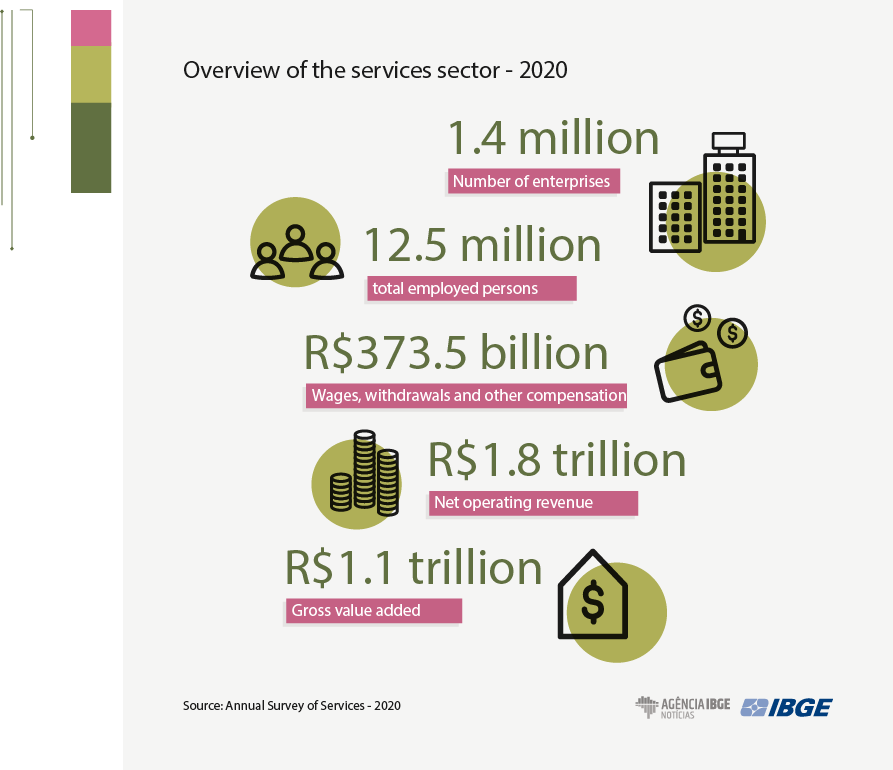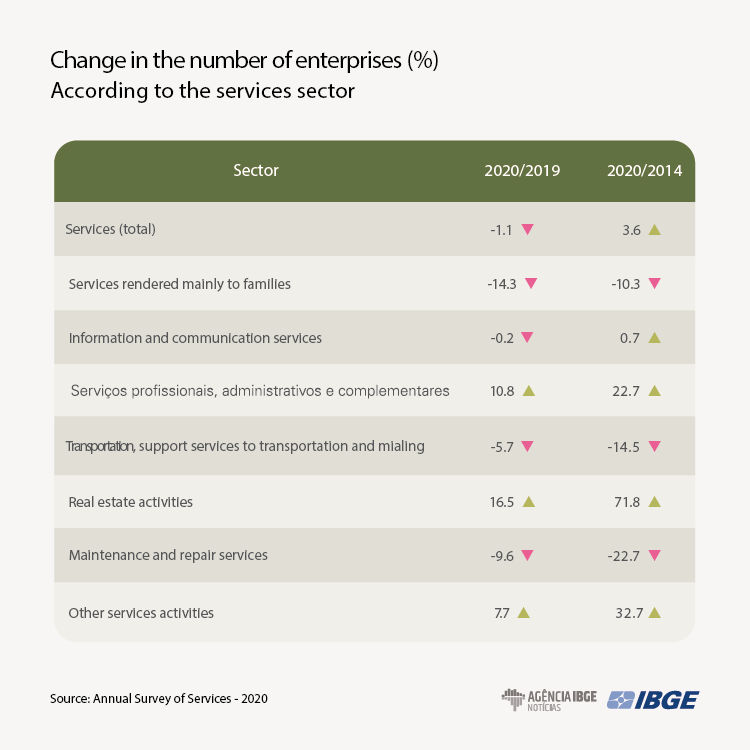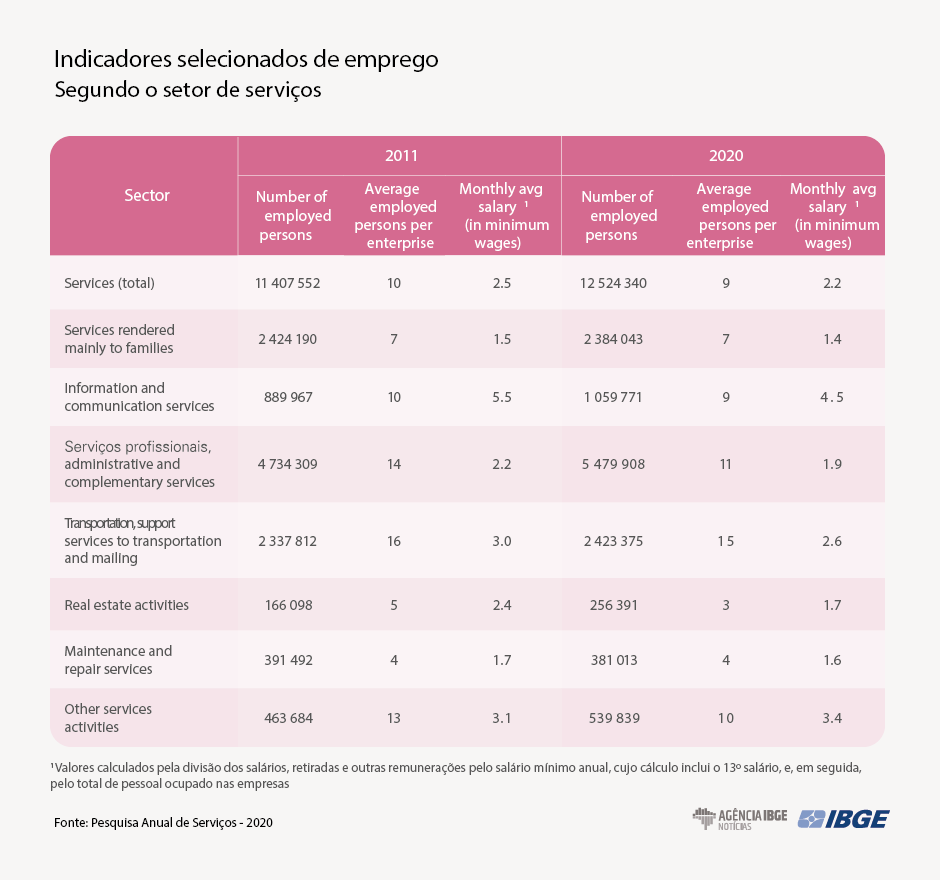Annual Survey of Services
Between 2019 and 2020, services sector loses 1.1% of enterprises and 2.4% of jobs
August 24, 2022 10h00 AM | Last Updated: August 26, 2022 11h27 AM
Highlights
- The number of enterprises in the services sector fell 1.1% over 2019, whereas employed personnel retreated 2.4%.
- In this period, the services sector rendered mainly to families registered the biggest proportional drop in the number of enterprises (-14.3%).
- Between 2019 and 2020, the activity of Recruitment, agencying and rental of workforce was the one that recorded the biggest increase of employed persons, both in absolute (143.1 thousand people) and percentage terms (22.2%).
- The activity that mostly lost personnel between 2019 and 2020, in absolute numbers, was Food services (-329.2 thousand people) and, in percentage, was Travel agencies, tourism operators and other tourism services (-28.4%).
- The monthly average salary dropped from 2.5 minimum wages in 2011 to 2.2 minimum wages in 2020.
- In 2020, the services sector had 1.4 million enterprises, producing R$1.8 trillion in net operating revenue and R$1.1 trillion of value added.
- The sector employed 12.5 million people, who earned R$373.5 billion in wages, withdrawals and other compensation.

The Annual Survey of Services (PAS) 2020 added up to 1,368,885 enterprises, a drop of 1.1% over 2019, mainly due to the retraction of 14.3% in the segment of services rendered mainly to families. Those enterprises employed 12.5 million people, paying R$373.5 billion in wages, withdrawals and compensation. The data were released by the IBGE today (24).

Professional, administrative and complementary services (504.5 thousand enterprises) and services rendered mainly to families (357.8 thousand) were the segments with the highest number of enterprises, jointly corresponding to 63.0% of the enterprises providing non-financial services in 2020.
In 2020, social distancing caused by the Covid-19 pandemic affected employment, development of enterprises and services provided face-to-face. Compared with 2019, while the GDP dropped 3.9%, the GDP of the services sector retreated 4.3%.

Employment falls 2.4% between 2019 and 2020
In 2020, the services sector employed 12.5 million people. The segment of professional, administrative and complementary services led the employment ranking, with 5.5 million people employed. In relation to 2019, the services sector lost 2.4% of the employed personnel.
“The activities that depended on face-to-face services were the mostly affected by the pandemic, which increased the drop in employment started in the 2014 crisis. Except for professional, administrative and complementary services, real estate activities and other service activities, the other segments registered a drop in employment,” stated Marcelo Miranda, an analyst of the survey.
Having dropped 16.4% or less 467.9 thousand jobs, services rendered mainly to families was the most affected sector. Within that segment, the most intense negative influence came from food services: -18.7% or less 329.2 thousand employed persons. Travel agencies, tourism operators and other tourism activities also dropped (28.4%), as well as edition integrated with printing (21.2%).
Among the major rises, the highlight was recruitment, agencying and rental of workforce, which represents outsourcing, an option of many companies during the pandemic. “It was the biggest increase of persons in absolute numbers (143.1 thousand) and in percentage (22.2%),” analyzes Miranda.
Average salary dropped in 10 years
Between 2011 and 2020, the average employment of the services sector dropped from ten to nine persons per enterprise. Of the four activities of larger enterprises, three are in the segment of transportation, support services to transportation and mailing, which had the highest average employment: 15 workers per enterprise. The activity of air transportation was the one that registered the highest negative change in absolute terms (-41 persons).
“The size of the enterprises changed a little in ten years, changing from an average of ten to nine employed persons, except for professional, administrative and complementary services and other service activities, which dropped from 14 to 11 and from 13 to 10. Concerning salaries, all the segments dropped, except other service activities. The highlight is the segment of information and communication services, which pays the highest salary, though it also dropped,” states the PAS analyst.
The monthly average salary retreated, changing from 2.5 minimum wages (s.m.) in 2011 to 2.2 s.m. in 2020. Information and communication services (4.5 s.m.) remained with the highest compensation in average salaries, though it recorded the biggest reduction (1.0 s.m.). That result was influenced by the activity of telecommunications, which reduced 2.1 s.m. in ten years.
Other service activities (3.4 s.m.) and transportation, support services to transportation and mailing (2.6 s.m.) remained paying salaries above the sector average in 2020. Services rendered mainly to families registered the lowest salary average (1.4 s.m.).

In ten years, South and Central-West increased their share in services revenue
Between 2011 and 2020, three out of five Major Regions lost share in revenue. The Southeast, which concentrated the highest portion of the gross revenue, lost 0.7 percentage points (p.p.), changing from 66.1% to 65.4%, whereas the Northeast fell from 10.2% to 9.5% and the North, from 2.8% to 2.6%. Only the South (14.1% to 15.0%) and Central-West (6.8% to 7.4%) increased their share, showing gains of 0.9 p.p. and 0.6 p.p. in ten years.
All the regions recorded drops in the salaries, with the Southeast, North and Central-West showing the biggest losses: 0.3 s.m. The South and Northeast regions lost 0.2 s.m.
Professional services surpasses Transportation and leads in net revenue
In 2020, the services sector produced R$1.8 trillion of net operating revenue. Between 2019 and 2020, the biggest increases in share in services revenue were professional, administrative and complementary services (1.7 p.p.) and other service activities (1.3 p.p.). On the other hand, the biggest drops were services rendered mainly to families (2.6 p.p.) and transportation, support services to transportation and mailing (1.0 p.p.).
The sector of professional, administrative and complementary services encompasses, for example, technical and professional services, law firms, accounting firms, recruitment and allocation of workforce and travel agencies. It was the third biggest segment up to 2011, it ranked in the second position in 2012 and, in 2020, surpassed the segment of transportation, support services to transportation and mailing, becoming the leader. “It is worth reminding that the sector of transportation suffered a lot during the pandemic,” explains Marcelo Miranda.



















